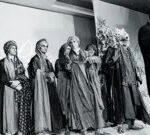Metaverse Fashion Week has once again redefined the landscape of fashion presentation, moving far beyond the confines of traditional runways. This year’s event, showcasing over 60 designers and brands, offered a glimpse into the future where fashion shows are unbound by physical limitations, embracing digital innovation and immersive experiences. While traditional fashion shows rely on physical venues and tangible garments, the metaverse provides a canvas for boundless creativity, as seen in floating runways and colossal digital installations.
Adidas embraced this digital frontier with a virtual fashion show that reimagined the runway itself. Models traversed a dynamic, gyrosphere-like structure, defying gravity and presenting digital wearables in a truly innovative format. This approach contrasts sharply with Traditional Fashion Show Images, which typically feature models walking in a linear path, emphasizing the garments’ physical drape and movement in a real-world setting. The metaverse allows brands like Adidas to experiment with surreal and imaginative presentations, enhancing the visual impact of their digital collections.
Art in the metaverse also serves to honor the legacies of traditional fashion icons, bridging the gap between the established world of fashion and its digital evolution. An immersive digital exhibit by Vueltta paid tribute to Vivienne Westwood, a designer renowned for her rebellious spirit and physical runway shows that were as much performance art as clothing displays.
This exhibit, while existing solely in the digital realm, echoes Westwood’s physical shows’ impact by creating an engaging experience that reflects her values and design ethos. Traditional fashion show images of Westwood’s work capture the energy of live performances; the metaverse exhibit translates this energy into an interactive digital space, allowing a new generation to engage with her legacy.
The Institute of Digital Fashion (IoDF) further challenges traditional fashion norms within the metaverse. By collaborating with designer Bradley Sharpe, IoDF presented digital collections that provoke thought about consumerism and sustainability, issues increasingly relevant to both traditional and digital fashion.
One digital piece explicitly questioned, “At the end of the world, do you need more clothes?”, a stark contrast to the aspirational messaging often found in traditional fashion show images that promote desire and consumption. IoDF uses the metaverse to critique the very industry it inhabits, pushing for a more conscious approach to fashion in both digital and physical realms.
Coach also ventured into the metaverse, creating an interactive experience around its iconic Tabby bag. Instead of a traditional runway presentation, Coach opted for an immersive digital space where users could engage with the brand and its products in a playful and exploratory manner.
This diverges from traditional fashion show images that focus on the handbag as an accessory carried by models; instead, Coach transforms the Tabby bag into a central element of a virtual world, inviting interaction and deeper brand engagement. This approach highlights the shift from passive observation in traditional fashion shows to active participation in metaverse experiences.
Tommy Hilfiger’s multi-metaverse hub represents another evolution beyond traditional fashion shows. By creating a central digital location that connects to various metaverse platforms, Tommy Hilfiger expands its reach and offers diverse experiences, from digital shopping to design competitions.
This multi-faceted approach moves away from the singular event of a traditional fashion show, transforming brand presence into an always-accessible digital environment. While traditional fashion show images capture fleeting moments on a runway, Tommy Hilfiger’s metaverse hub establishes a persistent brand world, offering continuous engagement and evolving the concept of brand presentation in the digital age. Metaverse Fashion Week and the innovations it showcases signal a significant departure from traditional fashion show formats, offering new avenues for creativity, brand engagement, and the very definition of fashion imagery.

